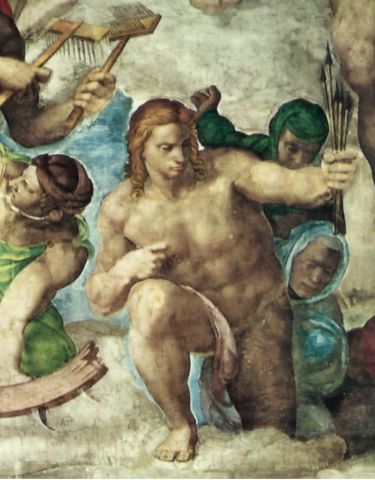"Le pape Sixte IV a fait aménager la chapelle Sixtine (à laquelle il donne son nom) du Vatican et c'est Michel-Ange qui en a peint les fresques vers 1540. Dans l'une des principales sections, quatre cents figures représentent le Jugement Dernier. Le Paradis en couvre plus de la moitié de la surface, avec, au centre, le Christ en juge et près de lui, la Vierge Marie. Au dessous les âmes des jugés montent au ciel, et plus bas encore, à gauche, on voit celles qui sont entraînées en enfer, au centre les anges qui réveillent les morts de leurs tombes, et à droite la barque de Charon."...
"The pope Sixtus IV made do up the chapel Sistine (to which he gives his name) in the 
... "Près du Christ et parmi d'autres saints, on peut voir Saint Sébastien, caractérisé par un faisceau des flèches qu'il tient dans sa main gauche. C'est ainsi que le peintre a voulu représenter son statut de soldat romain, en chef de la garde personnelle du cruel empereur Dioclétien. Sa stature est l'une des plus fortes de la fresque, le thorax est massif et presque carré, les bras courts et larges. La disposition des mains est aussi indicateur de force et de décision. En revanche, le visage dénote beaucoup plus de sensibilité, et les cheveux tombent ondulés sur les épaules. L'extrémité d'un tissu couvre à peine une partie de l'aine, en prenant la forme du membre qu'il cache, d'un volume résolument plus grand que pour les autres figures masculines imaginées par Michel Ángelo. Le Saint-Sébastien se détache comme l'une des plus belles représentations, puissantes et bonnes du Jugement Universel, peint sobrement dans de diverses tonalités d'ocre, près d'autres formes multicolores, et sur un fond de ciel clair."
..."Near Christ and among other saints, you can see Saint Sebastian, characterized by a beam of the arrows which he holds in the left hand. That's how the painter wanted to represent his status of Roman, chief soldier of the personal guard of the cruel emperor Diocletian. His stature is one of the strongest of the fresco; the thorax is massive and almost ensconced; the arms are broad and short. The disposition of hands is also indicator of force and decision. Nevertheless, the face denotes much more feelings, and hair falls wavy on his shoulders. The end of a cloth barely covers a part of the groin by taking the form of the member which it hides, of a resolutely bigger volume than for other masculine characters imagined by Michelangelo. Saint Sebastian breaks loose as one of the nicest presentations, powerful and good of Last Judgement, painted with moderation in various tonalities of ochre, near other multicoloured forms, and on a background of clear sky."
Manuel Puig. The Buenos Aires Affair. Buenos Aires, South America, 1973. P. 217
Traduction d'après le blog d'un autre passionné de St Sébastien: Linkillo (cosas mías)
Translation from the blog of another St Sebastian fan : Linkillo (cosas mías)

Aucun commentaire:
Enregistrer un commentaire